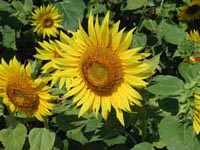Resource Library
Plant of the Week: Sunflower (Mile-a-minute Vine)
The University of Arkansas System Division of Agriculture does not promote, support or recommend plants featured in "Plant of the Week." Please consult your local Extension office for plants suitable for your region.
Plant of the Week
Sunflower
Latin: Helianthus annuus

County fairs are a curious amalgam of nostalgic and contemporaneous events that remind us of the way it was in rural America in a supposedly simpler time.
Competition to have the biggest and best in the county is keen and comes in many forms. The giant sunflower heads the list of the most unusual in plant exhibits. These sunflower giants may have been grown down on the farm in bygone days, but they were in grandmother’s flower garden not in grandfather’s fields.
The story of how this all-American weed became an important crop plant bears a closer look.
The sunflower, Helianthus annuus, is a member of the daisy family with wide distribution across the United States. Sunflowers are large plants with two distinct architectures. The wild type can grow 10 to 12 feet tall with considerable branching, each of which terminates in 5-inch diameter blooms.
The cultivated sunflower has lost the ability to branch and can grow to 15 feet tall with a single flower head atop the stout stem that may be the size of a garbage can lid.
When European explorers arrived in the 1500s, they found native Americans growing this unbranched mutant wherever they went. Sunflower never became a part of the diet of the more advance cultures of southern Mexico.
A sunflower bloom is not really a flower but a specialized flat inflorescence that bears hundreds of tiny individual flowers.
When the sunflower arrived in Europe, it was a big hit because people were amazed by the rank growth and gaudy spectacle of the flower. It quickly spread throughout Europe but remained a curiosity in the garden.
By the early 18th century, the seeds were considered nutritious poultry food, but otherwise the plant remained a novelty of little value.
The Russians were credited with the rise of sunflowers to agricultural stardom. They developed two types of sunflowers. The large-seeded types were developed as a snack food, much as peanuts were used in the rest of the world. The sunflowers grown in the U.S. today are descendants of varieties the Russians sent us at the close of the 19th century.
The more important sunflowers though were the small seeded oil types. During the Communist era, Russian agriculturists increased the oil content of these selections from about 28 percent to over 50 percent. The oil was used in everything from cooking to paint and by 1980 sunflower was the second most important crop oil in the world.
After all of those years being berated for having named a weed the state flower, Kansans could finally hold their head up proudly.
During the 1990s sunflowers were rediscovered by American gardeners and interior designers. The rise in the specialty cut flower market - especially at farmers markets around the nation - has lead to the development of a number of sunflower selections suitable for this purpose.
The sunflower motif became popular theme in interior decoration and has been plastered on about every imaginable surface.
Using sunflowers in the garden requires special consideration. They require full sun and a fertile, moist soil to reach their full potential.
Unlike most garden plants, sunflowers should never be grown in a pot but instead the seeds planted in hills containing three to five seeds directly where you want the plant. Thin the hills to one vigorous seedling when the seeds emerge. Plant the hills 2 feet apart to achieve the largest possible plants. Because sunflowers just produce a single flower, their bloom time is short. Plant new hills every three to four weeks to ensure continual bloom.
By: Gerald Klingaman, retired
Extension Horticulturist - Ornamentals
Extension News - September 6, 2002
The University of Arkansas System Division of Agriculture does not maintain lists of retail outlets where these plants can be purchased. Please check your local nursery or other retail outlets to ask about the availability of these plants for your growing area.